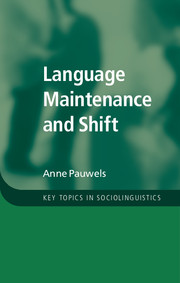Book contents
- Frontmatter
- Dedication
- Contents
- Acknowledgements
- Introduction
- PART I HISTORY, CONCEPTS, CONTEXTS AND APPROACHES
- PART II INVESTIGATING LANGUAGE MAINTENANCE AND SHIFT: COLLECTING AND ANALYSING DATA
- PART III IDENTIFYING AND UNDERSTANDING TRENDS AND PATTERNS IN THE DYNAMICS OF LANGUAGE MAINTENANCE AND SHIFT
- 6 Trends and patterns in language maintenance and shift
- 7 Understanding the dynamics of language maintenance and shift
- PART IV LANGUAGE MAINTENANCE EFFORTS AND REVERSING LANGUAGE SHIFT
- PART V FUTURE DEVELOPMENTS IN THE STUDY OF LANGUAGE MAINTENANCE AND SHIFT
- References
- Index
- References
6 - Trends and patterns in language maintenance and shift
from PART III - IDENTIFYING AND UNDERSTANDING TRENDS AND PATTERNS IN THE DYNAMICS OF LANGUAGE MAINTENANCE AND SHIFT
Published online by Cambridge University Press: 05 August 2016
- Frontmatter
- Dedication
- Contents
- Acknowledgements
- Introduction
- PART I HISTORY, CONCEPTS, CONTEXTS AND APPROACHES
- PART II INVESTIGATING LANGUAGE MAINTENANCE AND SHIFT: COLLECTING AND ANALYSING DATA
- PART III IDENTIFYING AND UNDERSTANDING TRENDS AND PATTERNS IN THE DYNAMICS OF LANGUAGE MAINTENANCE AND SHIFT
- 6 Trends and patterns in language maintenance and shift
- 7 Understanding the dynamics of language maintenance and shift
- PART IV LANGUAGE MAINTENANCE EFFORTS AND REVERSING LANGUAGE SHIFT
- PART V FUTURE DEVELOPMENTS IN THE STUDY OF LANGUAGE MAINTENANCE AND SHIFT
- References
- Index
- References
Summary
In Part II we described various data collection methods and tools that have been used or developed to investigate language practices and patterns associated with our two main settings: migrant communities and territorial linguistic minorities. In Part III we move to a discussion of findings emanating from the wealth of studies that made use of these various methods to examine questions of LM and LS. Indeed there have been hundreds, if not thousands of studies around the world examining LM and LS in our two main settings. Given this wealth, it is not surprising that a multitude of factors and forces influencing the process of LM or LS has been unearthed. Here we will focus on those factors that have been studied most widely and on discussing common trends or patterns that have been observed across this wide variety of studies. Some factors influencing LM and LS concern individual characteristics (variables) such as age, gender, educational background, social class, race/ethnicity, religious affiliation or marital status. Other factors apply mainly to groups. These include but are not limited to, the numerical strength of a group, its settlement patterns and its linguistic or cultural similarity to the dominant or majority group. Further factors that influence LM and LS relate to the majority group and/or the polity within which the minority finds itself. They include, for example, the majority's attitude towards the minority, its language and culture and the existence of laws and policies that support or oppose linguistic diversity, bi- and multilingualism. In this chapter, our discussion of common trends and patterns centres around two focal points: in Section 6.1 our focus is on variables and characteristics of the speaker or language user; i.e., this concerns the ‘who’ in the central question of ‘Who speaks what language to whom and when?’ The other focal point relates to other elements of the key question – to whom and when – that refer to contexts of use or domains. These will be taken up in Section 6.2. In both sections we will try to establish whether a specific speaker characteristic or context can be clear-cut, i.e., clearly enhancing LM or clearly leading to LS.
- Type
- Chapter
- Information
- Language Maintenance and Shift , pp. 83 - 99Publisher: Cambridge University PressPrint publication year: 2016

